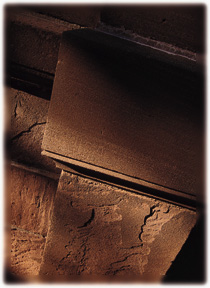Main Menu · Search · Current Issue · Contact · Archives · Centennial · Letters to the Editor · FAQs


|
The best geology exhibits at Harvard aren't in a museum. The University buildings themselves are the display cases. They feature a range of rocks as diverse as any assembled by plate tectonics. One building reveals a world of marine fossils. Another incorporates gray-and-black granite that solidified hundreds of millions of years ago. A third is made from a red sediment deposited in a land teeming with dinosaurs. A careful examination of these structures offers insights into cultural as well as natural history.
 The stairway of Harvard Hall (here and above) demonstrates that if masons laid the brownstone with its bedding planes vertical, winter crumbled it.Harvard Hall in winter, above, by Christopher S. Johnson.
The stairway of Harvard Hall (here and above) demonstrates that if masons laid the brownstone with its bedding planes vertical, winter crumbled it.Harvard Hall in winter, above, by Christopher S. Johnson. |
Harvard's earliest builders used locally abundant rock. Harvard Hall (1766, with additions in 1842 and 1870), by the main gate to the Yard, exemplifies this practice with a course of sandstone at its base and sandstone steps quarried from the Connecticut River valley. Although the red sandstone's official geologic name is the Portland Formation, more people probably know it as brownstone--a dominant building material during the last half of the nineteenth century in Boston, New York, and Philadelphia. Boston Brahmin Oliver Wendell Holmes, A.B. 1829, M.D. '36, celebrated this material in his poem "Contentment":
Little I ask; my wants are few;
I only wish a hut of stone,
(A very plain brown stone will do,)
That I may call my own;--
And close at hand is such a one,
In yonder street that fronts the sun.
Quarries in the Connecticut River valley started shipping brownstone in the middle 1600s. The peak of quarrying in East Longmeadow, Massachusetts, the state's principal brownstone region, occurred after rail service reached the town in 1876. Three or four trains per day would leave carrying as many as 17 cars of rock. Labor strikes in the 1890s forced the quarry industry into decline. By 1915 the major sandstone producers had shut down, and minimal amounts of building blocks have trickled out during the past 80 years.
Deposition of the Portland Formation sediments began 200 million years ago when Massachusetts sat about 15 degrees north of the equator. Streams washing westward out of a now eroded mountain chain deposited mostly red sands and silts more than 6,000 feet deep onto a vast valley floor, created as North America and Africa wrenched apart from each other. The climate fluctuated between humid and semi-arid periods lasting hundreds of thousands of years. Conifers, horsetails (scouring rushes), and ferns grew near the water. Three- to nine-foot-long carnivorous and herbivorous dinosaurs roamed about with lizard-like and crocodile-like reptiles. Unfortunately, these plants and animals did not leave traces in the rocks used at Harvard. Neither did the numerous species of fish that swam in the streams and perennial lakes, in which sediments slowly accumulated in layers called bedding planes.
The orientation of these beds in the Harvard Hall sandstone has left some blocks unscathed, while others crumble when touched. In winter, whenever the temperature rises above 32 degrees Fahrenheit, water infiltrates the porous sandstone of the hall's steps. When temperatures fall below freezing again, the water turns to ice and expands 9 percent. If a builder places a sandstone block with its beds vertical and parallel to the building's surface, the freeze/thaw cycle will force the layers to separate like cards off a deck. But if the beds lie horizontally, water cannot penetrate the layers, and the rock does not deteriorate.
Main Menu ·
Search · Current Issue · Contact · Archives · Centennial · Letters to the Editor · FAQs
![]()